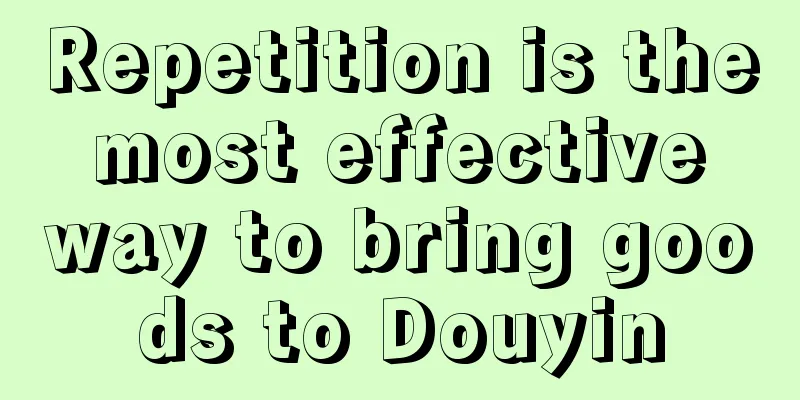A complete case study to understand how to create user portraits

A classmate asked: I see people bragging about user portraits everywhere, but I have never seen a real example. Today we will give you a real example of using user portraits to increase transaction volume. Moreover, this example happened around us. I encountered it when I was taking care of my child, and it was still fresh and fresh. 1. A real-life user portrait exampleThe sky was clear and the breeze was blowing. Dad took Coco out to play. They saw a lot of people flying kites by a lake. Suddenly, he thought: Let's go fly one too! Coco said: Yes! So the two of them went to buy a kite from a hawker (Cantonese, referring to an unlicensed street vendor). Seeing that Coco liked it, Dad was ready to pay, but unexpectedly, there was the following paragraph: Then Dad and Coco went to fly a kite happily. But I thought afterwards: Isn’t this the complete process of using a recommendation system to improve transactions based on user portraits? Data collection-labeling-product recommendation-upward sales are done in one go, and a second recommendation is made to improve the transaction rate and customer unit price separately. It is really clever. Although the uncle does not have any big data system and does not know how to write code, his way of doing things is far better than the newcomers who are still asking everywhere, "What are the algorithms for recommending kites?", "How do BAT sell kites?", "I am in the Internet kite industry, is there any big shot who understands Internet kite issues?" After all, practice makes perfect, and plagiarism lowers IQ . However, if you think about it carefully, things are not that simple: there are so many people selling toys, why kites? 2. The Real Purpose of User PortraitsParents who often take their kids out for a walk are familiar with the fact that in parks, ponds, and near grassy areas, there are small vendors selling bubble sticks, toy guns, magic wands, sand-digging tools, kites, and other toys. They all seem to be selling toys, but if you take a closer look, the differences between the different toys are very obvious. 1. Toy guns, magic wandsThe style of this kind of toys is very important! Whether it is the magic wand of Balala the Fairies or the 98K of PUBG directly determines whether the children will buy it. This is a typical case of: hot-selling driven. Hot-selling can be created artificially. What is tested here is the business design and promotion ability. If the style selection is not good, everything will be in vain. No matter how good the recommendation system is, it can't help. 2. Bubble WandThe selling point of this type of toy is very prominent: bubbles flying all over the sky. So it doesn't need to be recommended at all. You just need to ambush on the roadside, wait for a group of children to come over, and then shout to the sky, and a lot of bubbles will fly towards the children. Then nine out of ten children will want to buy it. This is a typical: experience-driven. What is tested here is sales ability, let users experience the effect. Otherwise, if you don't let them experience it, and just keep recommending it, they will still throw it away. 3. Sand bucketThis thing is highly homogeneous (a square-headed shovel, a pointed shovel, a rake, a small shovel, a shell model, a starfish model, a small bucket, the same model across the country). And the function is very clear and single: digging sand! For parents, there is nothing to say. If it is cheap, buy it. If it is expensive, don't buy it. It is a typical price-driven thing. What is tested here is the pricing. If the price is expensive, no matter how much you recommend it, parents will not be cheated. Kites, by contrast, are quite unique:
Especially for the vagrant uncle, if he really spread all the kites on the ground, he would not be able to escape even if the urban management came! Moreover, spreading dozens of kites on the ground would not look good, and it would be very difficult for parents to choose. You know, few parents are willing to take their children to the stalls to buy things. Most of them are afraid of/being made to do so by their children crying and making trouble. So the more choices you add, the more chances you have of losing customers. Therefore, the recommendation system is very useful here. Comparing these four categories, we found that the recommendation system is only an auxiliary tool for product management, which is suitable for non-explosive products and products with certain differences between categories. However, every tactic of product management is related to user portraits. Only by understanding users can we accurately meet their needs. So don’t just think of recommendations when you mention user portraits. There is still more work to be done (as shown in the figure below). 3. Why is it difficult to create useful user portraits?Since user portraits are so useful, why do we always think that user portraits are just a bunch of data piled up there, but in the end they are useless? Because if you want to make a useful user portrait, you need to avoid too many pitfalls. 1. No clear purposeIf the ghost uncle meets parents and doesn't ask what they want to buy, but just chats with them, can he still sell kites? Of course not, maybe he just feels good talking nonsense. This is the difference between having a goal and not having a goal. In work, many people make user portraits based on: "The leader asked me to do it" and "I see everyone is doing it." As for:
Never thought about it If this works, damn. 2. Data quality is not guaranteedNote that the uncle clearly saw a father and a child coming over, but he still asked: "Is it the adults or the children?" He did not take it for granted, which is a manifestation of professionalism. Because toys are a typical scene where users and buyers are separated, especially kites, which can be played by adults and children. At this time, it is very important to confirm the authenticity. In work, we often talk about data quality. Data quality is the premise of all analysis, and many companies underestimate the rigor of data collection. After the so-called "label diffusion method" came out, there was a group of newcomers who thought that they didn't need to collect data, as long as they had an algorithm, they could calculate the real data. This is really cutting off their own way. The higher the data quality, the better. 3. No labeling, just numbersNote that what the uncle asked is a label, not raw data. For example, an adult may have a height of 150, and a child may also have a height of 150. So why ask for a label instead of a specific value? First, it is easier to collect data by asking for labels. Second, the label of a child not only represents height, but also aesthetics, which is much more useful than raw data. This is the intuitive embodiment of the role of labels: rich in meaning and easy to use. This is also the reason why we need to continue labeling after collecting data. Labels are refined and meaningful data classifications, which are much more useful than raw data. 4. Lack of verification of results and no iterationWhen it comes to the usefulness of labels, some people have developed a labeling frenzy and are crazy about labeling, regardless of whether they are useful or not, or how useful they are. In short, the more labels the better. But labels that have not been proven to work are the same as having no labels at all. Not to mention making more complex secondary and tertiary labels based on primary labels. Interestingly, Uncle Zougui used the strategy of two-level labeling. Note that if you say at the beginning: ordinary kites are 20, children's kites are 30, then it is very likely that parents will directly choose the 20. If you say at the beginning: kites are 30, it may scare parents away. But if you first confirm that the parents are willing to buy, and then recommend a more expensive reel that is "easy to use", the success rate will be greatly improved. Because it has been confirmed that this parent is willing to accommodate the child, and parents who are willing to accommodate their children will most likely buy an expensive reel. In fact, according to incomplete statistics, half of the reels on the scene are "easy to use". Hehe, you can taste it carefully. V. SummaryOf course, the above is just Mr. Chen's exaggeration. The uncle may just be smart enough and didn't think so much. But this kind of intuitive example is very suitable for everyone to remember. Next time when you are confused about "What is the use of user portraits????", you can think about it again. There is another small problem here. This process seems very simple. Why do we need professional data analysts to do it? Business personnel can summarize it themselves. A: There are two reasons. First, the data volume in actual business scenarios is large and multi-dimensional, which is very time-consuming to process and requires professionals. If you see that your operations are not designing plans, selecting gifts, and investigating users, but are dealing with data for 8 hours a day, then the company is not far from bankruptcy. Secondly, the experience of business personnel can be easily defeated by short-term effects, and then make wrong judgments (as shown in the figure below). Business personnel are KPI-oriented and tend to choose short-term effects and ignore long-term effects. At this time, data analysts are needed to keep calm, observe for a long time, and accumulate experience. Only in this way can they better guide the business. Therefore, students who do data analysis must have confidence in themselves. The value of data is more than a complex model. Basic work, method accumulation, experience summary, and feedback to the business are all what we can do. The more difficult the method is, the better it is, but the more useful it is, the better it is. Remember this. Author: Down-to-earth Teacher Chen, Source: Official Account: "Down-to-earth Teacher Chen" |
<<: There has never been a simple and crude rule in the Internet industry.
Recommend
Why did Shopee not receive any orders for a month? What are the reasons?
Every merchant who opens a store online hopes that...
The four-step product selection method that ordinary people must learn to start an e-commerce business. I personally practiced and summarized the refined version
In this article, the author shares a product selec...
Top 10 Marketing Keywords in 2022 | Year-end Summary
In the context of the new era, some new trends hav...
Can eBay operators contact customers directly? What do operators need to do?
In the process of cross-border e-commerce, communi...
200 million people who stay up late using their mobile phones: their side life hidden in the night
What are the reasons why modern people stay up lat...
10 Marketing Trends for 2025
As 2024 draws to a close, we stand on the threshol...
From "rookie" to "expert": five steps to master new skills
In the journey of learning new skills, everyone st...
How do we create IP (goals, paths, planning, implementation)
If you can create a classic IP slogan, it will def...
The logic behind excellent brands: 22 laws of branding
"22 Laws of Branding" provides a strateg...
How is the starday platform? What are its advantages?
As the world's third largest economy, Japan ha...
How to register a parent-child account on Shopee? What is the method?
There are many merchants opening stores on the Sho...
100,000 people watched the auction. How did Sprite, which was founded in 1982, use old tricks to create new growth on Douyin?
The once popular online meme "Sprite in 1982&...
Milk tea is exported overseas, priced at 50 yuan a cup, but the profit is not as good as doing odd jobs
Milk tea has gradually become an indispensable thi...
Short play Left Right 60 Days
In just 60 days, the short drama industry has ente...
How can Xiaohongshu be run without focusing on content?
In the operation of Xiaohongshu, merchants should ...




![This is too much, this [operation analysis] idea is really on point](/upload/images/67e6df251523f.webp)




